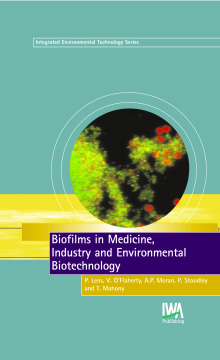
BOOK
Biofilms in Medicine, Industry and Environmental Biotechnology
Piet Lens | V. O'Flaherty | A. P. Moran | P. Stoodley | T. Mahony
(2003)
Additional Information
Book Details
Abstract
Biofilms are of great practical importance for beneficial technologies such as water and wastewater treatment and bioremediation of groundwater and soil. In other settings biofilms cause severe problems, for example in 65% of bacterial infections currently treated by clinicians (particularly those associated with prosthetics and implants), accelerated corrosion in industrial systems, oil souring and biofouling. Until recently, the structure and function of biofilms could only be inferred from gross measures of biomass and metabolic activity. This limitation meant that investigators involved in biofilm research and application had only a crude understanding of the microbial ecology, physical structure and chemical characteristics of biofilms. Consequently, opportunities for the exploitation and control of biofilms were very limited. The past decade has witnessed the development of several new techniques to elucidate the structure and function of biofilms. Examples include: the use of molecular probes that identify different microbes in complex communities as well as their metabolic functions; the use of microsensors that show concentration gradients of key nutrients and chemicals; the use of confocal laser scanning microscopy to describe the physical structure of biofilms and the development of a new generation of mathematical models that allow for the prediction of biofilm structure and function. However, much progress remains to be made in efforts to understand, control and exploit biofilms. This timely book will introduce its readers to the structure and function of biofilms at a fundamental level as determined during the past decade of research, including: Extracellular polymers as the biofilm matrix; Biofilm phenotype (differential gene expression, interspecies signalling); Biofilm ecology; Biofilm monitoring; Resistance of biofilms to antimicrobial agents and Biofilm abatement. Biofilms in Medicine, Industry and Environmental Technology offers a holistic and multi-disciplinary description of the topic, including biofilm formation and composition, but also biofilm monitoring, disinfection and control. All these aspects are presented from three points of views: medical, industrial and environmental biotechnological in a compact, easy to read format.
Table of Contents
| Section Title | Page | Action | Price |
|---|---|---|---|
| Contents | vi | ||
| PART ONE BIOFILM CHARACTERISTICS | 1 | ||
| Section 1 Biofilm formation | 3 | ||
| 1 Macroscopic and microscopic adhesive properties of microbial cell surfaces | 5 | ||
| 2 The role of hydrophobicity and exopolymers in initial adhesion and biofilm formation | 16 | ||
| 3 The role of coaggregation in oral biofilm formation | 32 | ||
| 4 Genetics of biofilm formation | 47 | ||
| 5 The role of cell signalling in biofilm development | 63 | ||
| Section 2 Biofilm composition | 79 | ||
| Section 2(A) Chemical | 79 | ||
| 6 Molecular architecture of the biofilm matrix | 81 | ||
| 7 Physico-chemical properties of extracellular polymeric substances | 91 | ||
| Section 2(B) Biological | 113 | ||
| 8 Biofilms on corroding materials | 115 | ||
| 9 Biofilms in wastewater treatment systems | 132 | ||
| 10 Bioaerosols and biofilms | 160 | ||
| 11 Biofilms and protozoa: a ubiquitous health hazard | 179 | ||
| PART TWO ANALYTICAL TECHNIQUES | 193 | ||
| Section 3 Biofilm cultivation apparatus | 195 | ||
| 12 Use of flow cells and annular reactors to study biofilms | 197 | ||
| 13 Experimental systems for studying biofilm growth in drinking water | 214 | ||
| 14 Efficacy testing of disinfectants using microbes grown in biofilm constructs | 230 | ||
| 15 Steady-state heterogeneous model systems in microbial ecology | 236 | ||
| Section 4 Analytical techniques for biofilm properties | 257 | ||
| Section 4(A) Physico-chemical properties | 257 | ||
| 16 Use of X-ray photoelectron spectroscopy and Atomic force microscopy for studying interfaces in biofilms | 259 | ||
| 17 Use of 1H NMR to study transport processes in biofilms | 285 | ||
| 18 Screening of lectins for staining lectin-specific glycoconjugates in the EPS of biofilms | 308 | ||
| Section 4(B) Biotic properties | 329 | ||
| 19 Environmental electron microscopy applied to biofilms | 331 | ||
| 20 Use of molecular probes to study biofilms | 352 | ||
| 21 Use of microsensors to study biofilms | 375 | ||
| 22 Use of mathematical modelling to study biofilm development and morphology | 413 | ||
| PART THREE CONTROL OF BIOFILMS | 439 | ||
| Section 5 Biofilm monitoring | 441 | ||
| 23 Biofilm monitoring by photoacoustic spectroscopy | 443 | ||
| 24 Quartz crystal microbalance with dissipation monitoring: a new tool for studying biofilm formation in real time | 450 | ||
| 25 Monitoring biofouling using infrared absorbance | 461 | ||
| Section 6 Biofilm disinfection | 471 | ||
| 26 Factors that affect disinfection of pathogenic biofilms | 473 | ||
| 27 Device-associated infection: the biofilm-related problem in health care | 503 | ||
| 28 Bacterial resistance to biocides: current knowledge and future problems | 512 | ||
| Section 7 Biofilm control | 535 | ||
| 29 Resistance of medical biofilms | 537 | ||
| 30 Control of biofilm in the food industry: a microbiological survey of high-risk processing facilities | 554 | ||
| 31 Industrial biofilms: formation, problems and control | 568 | ||
| 32 Microbial fouling control for industrial systems | 591 | ||
| Index | 607 |
